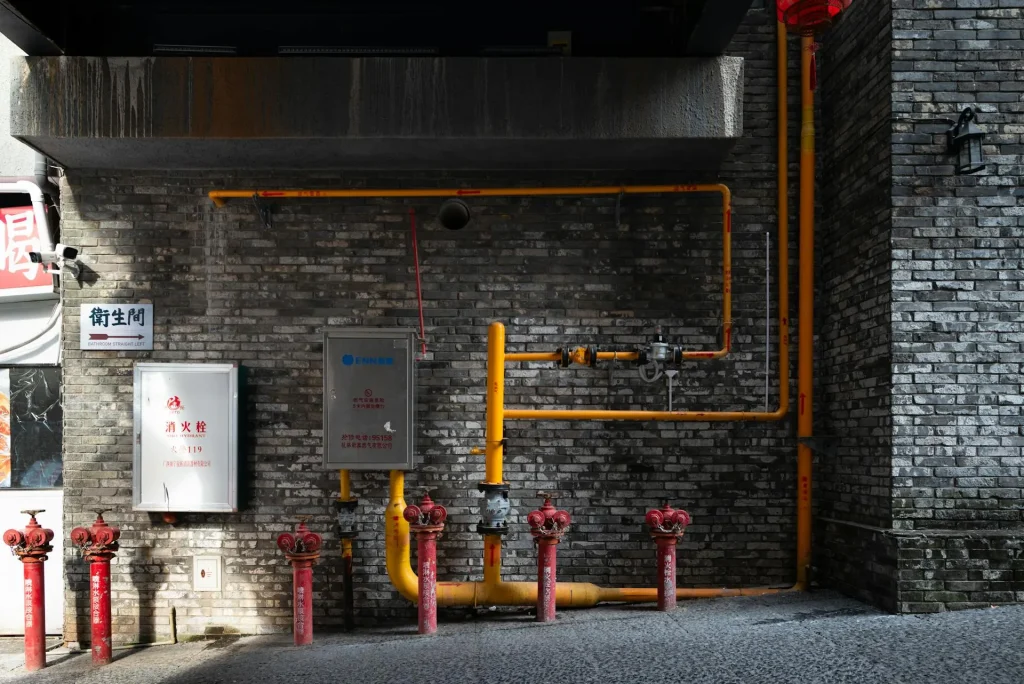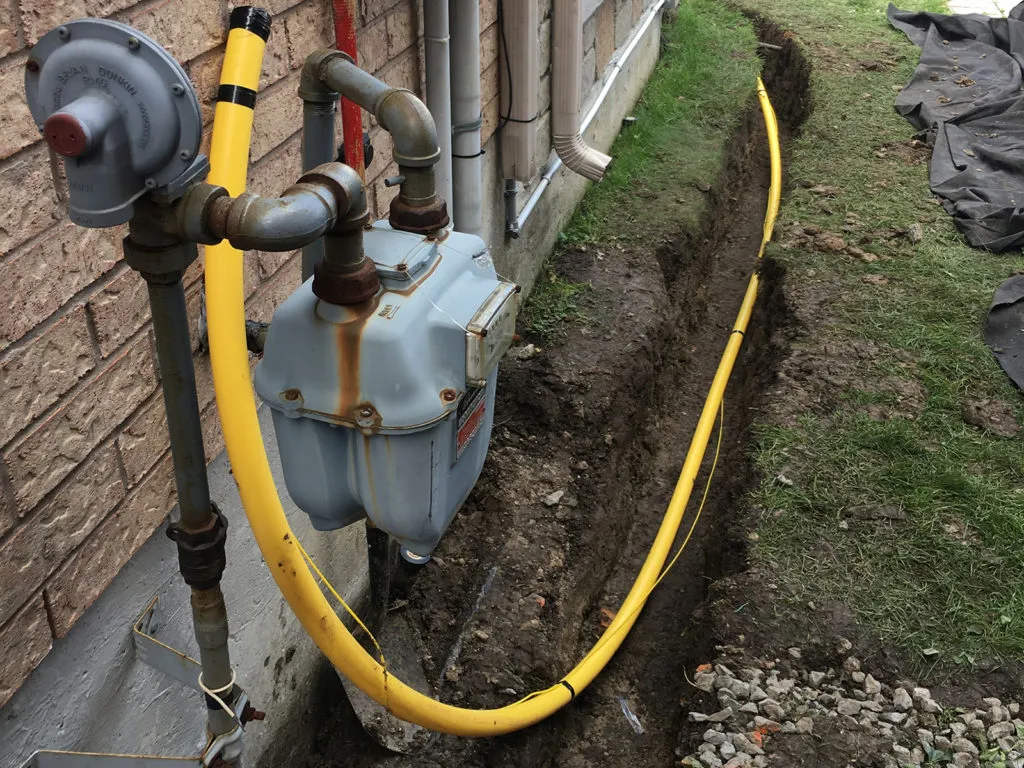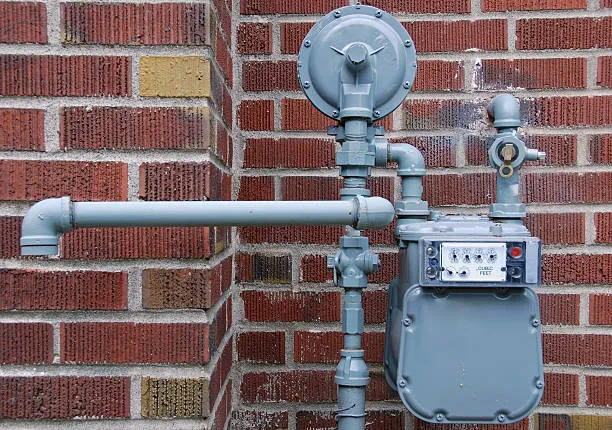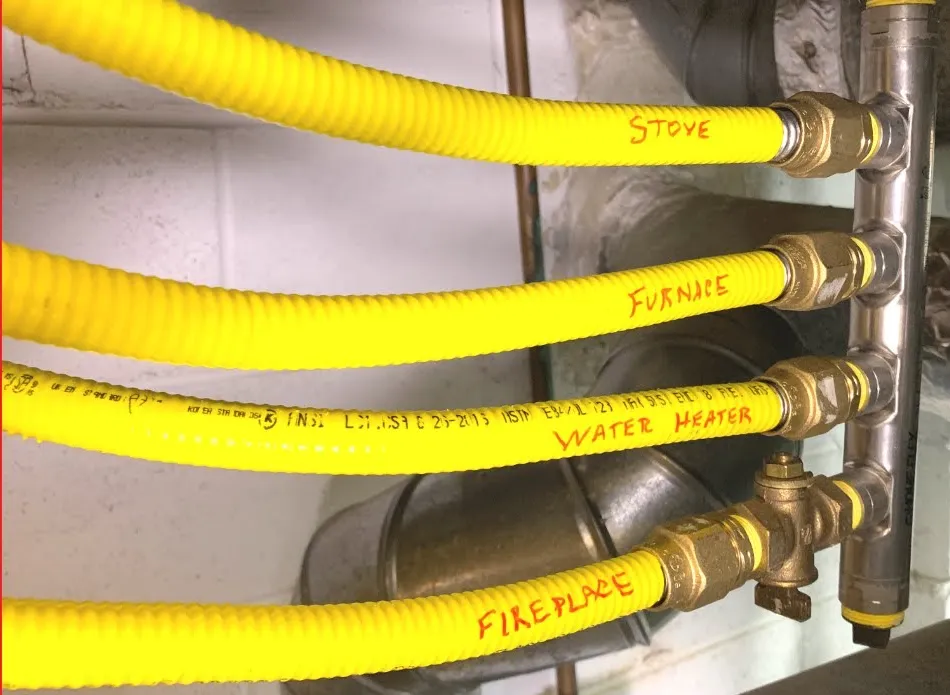

Ever tried to explain a furnace issue, only to be asked about the “gas meter” or “shutoff valve”? And all you can do is say, “I think so,” hoping they understand.
A repair call with your gas installation service can feel challenging if you don’t know what a gas line is or how it works.
But don’t worry. Here, we’ll help you learn the main parts of your system so you can describe problems more clearly when you need it most.
A gas line is a pipe or network of pipes that brings natural gas or LPG to your home. It powers your stove, water heater, and outdoor grill. It works like a water pipe but supplies energy instead of water.

Because it carries flammable fuel, its design focuses on pipeline safety. The residential gas system starts underground with a yellow plastic pipe that connects your home to the street’s main gas line.
This underground gas pipe surfaces and connects to your gas meter. The gas meter is a grey, rectangular box mounted outside with dials or a digital display showing your gas usage.
From the meter, interior gas piping runs inside your home. Common types include rigid black iron pipe, copper tubing, and modern multilayer pipes.
There are also valves along the pipe that will control gas flow. The main shut-off outside stops gas to the whole house, while smaller red or yellow-handled valves shut off gas to specific units.
Do you want to learn more about gas lines in your house? Here’s how it works:
Gas starts in large underground pipelines from production sites to cities. High pressure pushes it along, with compressor stations maintaining flow. It then moves into service lines that deliver it to homes and businesses.

It’s buried in a trench that goes from the road to the side of your house where the meter is. The gas company is responsible for this pipe. A gas line installation process ensures there are no issues with this part.
When the underground service line reaches your property, gas flows into the drop line. This is a vertical pipe that carries it above ground near the gas meter or building entrance.
It safely connects underground gas to the meter and inside pipes, and is firmly attached to stop leaks and harm.
Gas moves up through the riser pipe, which connects the drop line to the building’s meter. It brings gas safely from ground level into the building for measurement and distribution.
The pipe must be sturdy and well-supported to prevent damage and maintain flow. The riser keeps the system organised and leak-free.
Next, the gas in your home is measured by the gas meter. This is the rectangular box on the side of your house with dials or a digital display.
The meter shows how much gas is passing through, which helps your energy company know your bill. Any gas meter adjustment deals with this process.

After the meter, the main shut-off valve controls the gas flow into your home. It’s a simple switch. Turn the handle to stop or start the gas.
Usually placed right after the meter, it’s easy to reach. This valve is vital for safety. You can quickly shut off the gas, preventing accidents and giving you control when you need it.
Gas exits the shutoff valve and moves through the main supply pipe inside or beneath your home. This pipe, protected by burial, tubing, or safe placement, transports gas throughout your building.
Think of it as the main highway ensuring safe delivery to all areas. Maintenance is your responsibility beyond this point.
The main gas pipe branches out into smaller lines that lead directly to each appliance. These pipes run throughout your home, delivering gas safely and reliably to stoves, water heaters, and other devices.

They are installed following Australian safety standards, like AS/NZS 5601.1, to maintain steady pressure and ensure each appliance gets the right amount of gas.
Each gas appliance has its own shutoff valve nearby. This valve allows you to turn off the gas to just that appliance without affecting the rest of the system.
It’s easy to use. A small lever or knob controls it. With these valves, you can turn off one appliance while everything else keeps working.
When you turn on an appliance, gas comes in and is lit by a small flame or spark, which starts the burning that makes it work.
This flame heats your stove, water, or home, giving you comfort and the ability to cook. The system is built to keep gas flowing safely and automatically shuts off when not in use.
For example, modern instantaneous hot water systems use electronic ignitors that turn on only when hot water is needed, making them more efficient.
Learn More: How Gas Hot Water System Works
Here are the main types of gas lines pipes used in homes:
PE pipe is popular for underground gas lines due to its flexibility, light weight, and rust resistance.
It comes in long coils, which means there are fewer joints and less chance of leaks. It’s affordable and easy to install, making it great for new projects or repairs.
Black iron pipe has long been the standard for indoor gas lines due to its strength and leak-proof joints.
While durable and high-pressure capable, it can rust if exposed to moisture. That’s why it is commonly used indoors for gas connections.
CSST is a flexible stainless steel gas pipe coated with yellow or black polymer for protection. Its flexibility simplifies installation around obstacles. This reduces the need for fittings and potential leak points.
Mostly used indoors, CSST makes upgrades or renovations faster, cheaper, and safer.
Copper pipe isn’t used as much for gas lines anymore, but it’s still popular indoors. People like it because it resists rust, is easy to install, durable, lightweight, and flexible. Since it doesn’t rust, it’s good in damp areas.
Steel pipes are durable and zinc-coated to resist rust, ideal for outdoor gas lines and high-pressure uses. For main pipelines and large diameters, steel remains the top choice.
PVC pipe is popular for gas venting due to its lightness, affordability, and ease of installation. However, extreme conditions can cause brittleness, and it’s unsuitable for high-pressure or indoor use.
Here are some signs to check if your gas line is working properly:
Here are some questions about the gas pipe and how it works in your house:
Gas lines start outside at the gas metre or LPG tank and run through walls, floors, or underground to reach appliances. You’ll find them in the kitchen, laundry, near fireplaces, or outside for barbecues. The pipes are buried at least 0.3 to 0.45 metres deep.
Inside homes, gas lines are either black iron pipes or yellow CSST. They range from half an inch to two inches in diameter.
Underground, the main gas line is a durable HDPE pipe buried at least 0.45 metres deep. You’ll see visible gas lines as straight, threaded metal pipes, often painted to prevent corrosion.
The simplest way to check for gas is to find the meter outside your home. It’s a box with dials or a digital display connected to the pipes.
You can also check your appliances like stoves, water heaters, or furnaces for gas lines. Look for black iron pipes, yellow flexible tubing, or shut-off valves.
Outside, yellow markers or tracer wires might show where underground lines run. If you’re not sure, it’s best to call a licensed gas fitter to check.
You have learned what a gas line is and some related terms like riser, drop line, and service line. This knowledge will help you explain your concerns more clearly when you call about a gas repair.
Clear communication allows the plumber to understand the problem more quickly. However, knowing these terms is just to improve your communication. If you suspect a gas leak, do not attempt to fix it yourself.
Always trust your local gas experts, such as Melbourne Gas Plumber, to handle the repair. Your safety comes first.


Fill the form below and we’ll get back ASAP!

MGP! Thank you for help, honest pricing and high quality work. Thank you to Joe for pricing and the boys involved for replacing my hot water tank and fixing my gas leak for a reasonable price. 5 star response, 5 star service and 5 star price.
Joe was great. Very professional and quick. Gas hot water heater needed replacing, he was honest and upfront about what our options were. System was sourced and replaced within a couple of hours.
Fantastic service very responsive Joe is highly recommended and works very clean and neat..... good job well done....very happy... will use again and again

At Melbourne Gas Plumber, we're here to handle all your gas plumbing needs throughout Melbourne. With over 40 years of experience, we bring extensive local knowledge and expertise to every job.
QUICK LINKS
OPENING HOURS
Open 24/7
